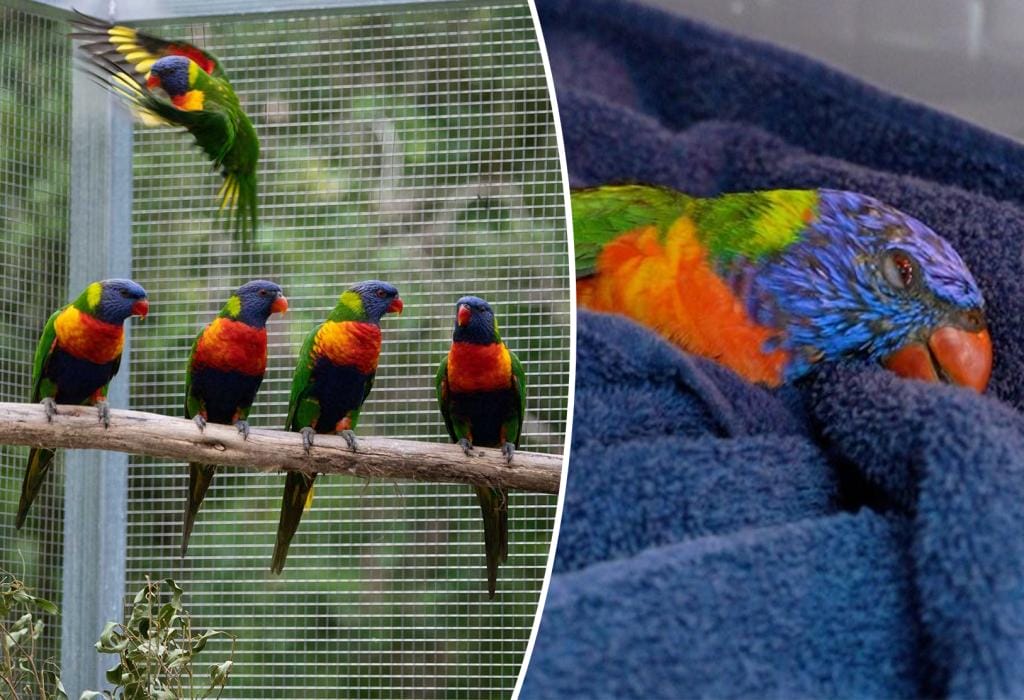Hundreds of rainbow lorikeets fell from the sky last week, paralyzed by a disease that researchers have struggled to understand.
More than 200 paralyzed birds were treated around Grafton in northern New South Wales, Australia, during the week to Thursday, affected by a little-known disease called lory paralysis syndrome (LPS).
About 40 percent of beautifully colored birds will not survive this unusual disease, the cause of which remains unknown.
Birds that can’t blink, can’t eat, can’t fly
LPS has killed thousands of rainbow lorikeets, mainly in southern Queensland, Australia and northern New South Wales, since the disease was identified in 2010.
Birds may appear unsteady as they hop on the ground, with varying degrees of paralysis of their legs and wings.
Hundreds of rainbow lorikeets fell from the sky in this Australian city last week, paralyzed by a mysterious disease that worries scientists. RSPCA
In more severe cases, paralysis can affect the entire body and the parrot may not be able to blink or swallow.
David Phalen, a professor of wildlife health and conservation who specializes in LPS, called it a “major animal welfare crisis.”
“These animals suffer terribly before dying or being killed by a cat or possum finding them,” he said.
More than 200 paralyzed birds were treated, affected by a little-known disease called lory paralysis syndrome (LPS). RSPCA
“They are amazing birds,” Professor Phalen added, speaking to Scientific American last year.
“They are intelligent. They are entertaining to watch. They are beautiful. It’s hard to see them as sick as they are. But at the same time they are fighters.”
Robyn Gray, WIRES avian co-ordinator in Clarence Valley, had more than 80 birds in her care this week and said: “Many of them don’t survive.”
Start your day with everything you need to know
Morning Report delivers the latest news, videos, photos and more.
Thanks for registering!
“When they arrive, they are underweight, malnourished and very sick birds,” he told ABC.
“We have professors in Sydney, Currumbin and Australia Zoo, at the University of Sydney, everyone is testing them and no one can give a definitive answer.”
Despite the grim outlook, veterinarians and volunteers are working tirelessly to rehabilitate sick birds.
In November, RSPCA Queensland took in four paralyzed parrots, which they named Mash, Chippy, Tater and Spud.
The birds were treated with fluid and nutritional therapy, painkillers and eye drops to combat their inability to blink.
“Sadly, Spud lost his battle against LPS,” the charity said in an update.
“However, Mash, Chippy and Tater continue to go from strength to strength. All three have shown incredible improvements. “Now they can perch and are also starting to feed themselves.”
Mysterious cause behind a worrying illness
Researchers have struggled to identify the factor behind LPS, but a prevailing theory is that it is caused by a pathogen that parrotlets ingest when they eat a particular fruit or flower.
The disease is seasonal, appearing each year between October and June and the highest number of cases between December and February, which could be explained if it is related to a summer plant.
“Not all fruits they eat are necessarily toxic, so it could be because a toxin is forming inside them, possibly because the fruit [fruit is] “It’s ringing,” Professor Phalen explained.
Robyn Gray, WIRES avian co-ordinator in Clarence Valley, had more than 80 birds in her care this week and said: “Many of them don’t survive.” RSPCA
“Or it could be [the fruit is] being inadvertently or intentionally sprayed with a pesticide or fungicide.”
But all known pesticides and fungicides have been ruled out, as well as the presence of an infectious disease.
“We still think there might be some toxins that we haven’t looked at that will be the focus of our research this year,” Professor Phalen said.
Call to the public to help
Researchers have struggled to identify the factor behind LPS, but a prevailing theory is that it is caused by a pathogen that parrotlets ingest when they eat a particular fruit or flower. RSPCA
In the face of so much uncertainty, scientists have asked the public for help.
Researchers from the Lorikeet Paralysis Syndrome Project have asked birdwatchers between Bundaberg and Grafton to report what they see rainbow lorikeets eating.
The information submitted will help narrow down the list of possible causes of LPS.
“We’re approaching this like a veterinarian investigating a patient,” Dr. Phalen said.
“Only it’s not just one patient. “It’s a whole flock.”
Categories: Trending
Source: vtt.edu.vn
